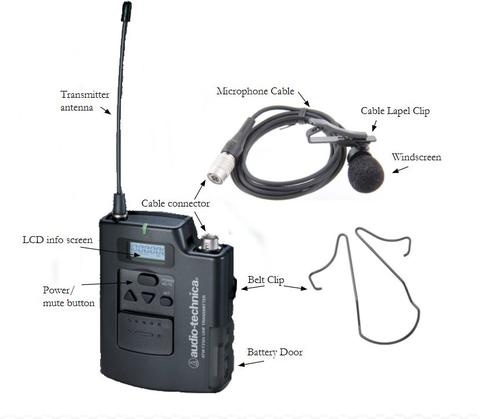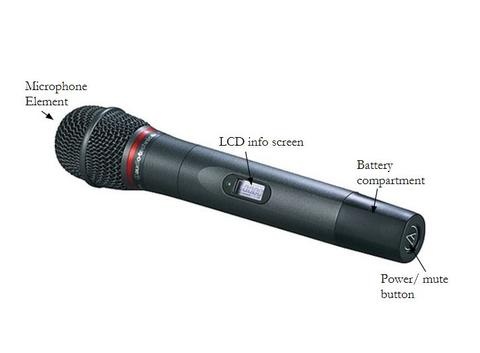University Classrooms use a variety of equipment to help create a better learning environment. Currently, all University Classrooms have a microphone, typically a wired/USB boundary microphone, to capture in-room audio. Select classrooms and large lecture classrooms, typically learning spaces with capacity for more than 70, also have wireless microphones to enhance audio for easier hearing. To see more information about a particular room and what is available consult the classrooms website.
Wireless Body Pack Microphone
The image below is an example of the Audio-Technica wireless body pack microphone. The Shure Wireless body pack microphone is also a common version installed in learning spaces. In most learning spaces, this is typically located on a lectern surface but may also be found in the microphone drawer of a room's A/V system rack or on a rechargeable base on the lectern.

Transmitter Antenna
This antenna transmits audio back to the in room receiver.
LCD Info Screen
- Displayed on this screen is the specific frequency assigned to the room
- It also shows battery status and if the microphone is muted
Power or Mute Button
- Hold down this button for three-seconds to turn the unit on and off
- Press the button for one-second to mute and unmute the microphone
Microphone Cable
- This cable connects the microphone element to the transmitter pack
Cable Connector
- Connection point between the microphone cable and the transmitter pack
Belt Clip
- This clip goes on the back of the pack and clips the transmitter pack onto a belt or waist
Battery Door
- Door typically covers two AA batteries or 9-Volt battery that powers body pack
- To change batteries, slide door lock down to unlock batter door, then push the two arrows together to open door
- Rechargeable batteries are typically located on battery charger, alkaline batteries are typically located within microphone drawer
- If using rechargeable battery supplies, remember to replace batteries on charger
- If nearing end of battery supplies, contact ITS Help Desk for resupply
Cable Lapel Clip
- Lapel clip holds microphone element up near audio source
Windscreen
- Foam cover for microphone element used to temper excess noise due to air movement
Wireless Handheld Microphone
This image below is an example of the Audio-Technica wireless handheld microphone. The Shure wireless handheld microphone is also a common version installed in learning spaces. In most learning spaces, this is typically located on a lectern surface but may also be found in the microphone drawer of a room's A/V system rack or on a rechargeable base on the lectern.

Microphone Element
- This part of the microphone that receives auto signals to be transmitted
LCD Info Screen
- Display on this screen is the specific frequency assigned to the room
- It also shows the battery status or if the microphone is muted
Battery Compartment
- The bottom portion of the microphone unscrews to get to the battery compartment. The microphone is powered two AA batteries or a 9-Volt battery
- How to change batteries: Gripping the microphone element in one hand, grasp and twist the battery compartment counterclockwise while slightly pulling down with the other
- Rechargeable batteries are typically located on battery charger, alkaline batteries are located n microphone drawer
- If using rechargeable battery supplies, remember to replace batteries on charger
- If nearing end of battery supplies, contact ITS Help Desk for resupply
Power or Mute Button
- Hold down this button for three-seconds to turn the unit on and off
- Press the button for one-second to mute or unmute the microphone
Battery Information
Learning Spaces Technology supplies batteries for Univeristy Classroom microphones only. Alkaline battery supplies are typically stored in the microphone drawer with microphones. Many classrooms use rechargeable batteries, which are stored on the lectern's battery charger. An average battery life span for two AA batteries in a microphone is about eight to ten hours. The LCD Info Screen displays the status of currently installed batteries. When a room's supply of batteries runs low, please contact the ITS Help Desk.
Have Questions?
We're here to help if you have any questions or classroom technology issues.